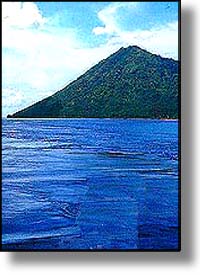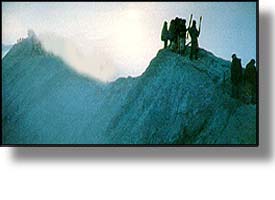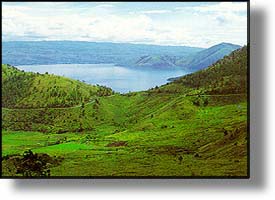Indonesia
Sumatra
Indonesia's largest and least developed province, Sumatra rests along the equator, heavily forested and rich in rare wildlife. The island's slow development has made it ideal for eco-tourism, and numerous large reserves and preservation areas have been set aside. Its most famous park, Mount Leuser National Park, is one of the last refuges of the Sumatra Orang-Utan.
Another distinguished park is the Berbak Wildlife Reserve, which has one of Indonesia's largest tiger populations. In the far north of the island is Lake Toba, an enormous and extraordinarily beautiful crater lake.
A particularly enthralling adventure experience in Sumatra takes place on the Alas River, which winds its across North Sumatra through jungle, limestone gorges, and native villages. The voyage begins in the Karo Highlands and culminates with the Indian Ocean: a descent ten times that of the Grand Canyon's Colorado River.
Sulawesi

With four huge peninsulas stretching out haphazardly into the South Pacific, Sulawesi's infamous shape has often been compared to that of a spider or an amoeba. The island lies just east of Kalimantan and north of Bali.
The island is divided into two regions, north and south, with its key city, Unjung Padang, situated on the island's southwestern leg. North Sulawesi and its [link]Bunaken Marine Park[link] is best known as Indonesia's mecca for divers and snorklers, while South Sulawesi harbors two of the country's most interesting cultures. In the far south, in and around Ujang Padang, are the Bugi people, long reknowned for their seafaring skills. Evidence of their influence has been found as far as Australia, where they had contact with the Aborigines. When the Portugeuse, British, Spanish, and Dutch came, the daring Bugis would often attack the huge colonial vessels on the open sea.
South Sulawesi is also home to the Toraja people, who live in a picturesque, mountainous region called Tana Toraja, or Toraja Land. At the center of Toraja culture is a fascinating and complex belief system surrounding death and the afterlife. Death is an elaborate affair, and the prolonged funerals are a major interest to visitors, who can attend the ceremonies but should show the same respect that they would for their own. The funerals typically involve feasting, buffalo sacrifice, dancing and martial arts, culminating with a procession that carries the coffin to its final resting place in one of the many caves on the surrounding cliffs, which are guarded by rock statues.
The Toraja's are equally famous for their houses, which are called Tongkonan, or Family Houses. The houses are built on stilts, and each end rises like the horns of a buffalo, with the points always facing north and south.
Bromo-Tengger National Park
 Long before there was a nation called Indonesia, there was Bromo-Tengger. This mystic, volcanic region was set aside by Hindus as a sacred place, and to this day thousands make a yearly pilgrimage to the park to honor Mount Semeru, which they consider to be a god.
Long before there was a nation called Indonesia, there was Bromo-Tengger. This mystic, volcanic region was set aside by Hindus as a sacred place, and to this day thousands make a yearly pilgrimage to the park to honor Mount Semeru, which they consider to be a god. The landscape of Bromo-Tengger is indeed heavenly. The park is situated around a group of forest encrusted volcanoes that rise up thousands of feet like gigantic, terrestrial limpets. At 3,676 meters, Semeru is Java's highest mountain, and it is still active, erupting once every eight minutes. Though Semeru is the highest mountain, no less astounding is Bromo.
Mount Bromo rests in what is known as the sand sea, a vast, empty expanse of sand 10 kilometers wide that is surrounded by interior slopes of another volcano that became extinct long ago. Bromo is also active, but visitors can trek to the mountain on foot or horseback and climb to the edge of its caldera and experience the spacial wonder of the sand sea below.
Bunaken Marine Park
The reefs of Bunaken Marine Park have been compared in richness to that of Australia's Great Barrier Reef, which is visible from outer space and is the largest concentration of life on the planet. At Bunaken, nearly 900 square kilometers of prime marine habitat have been set aside solely for the enjoyment of the diver, the snorkeler, and the researcher.
On a single dive in Bunaken, the visitor is sometimes greeted by a dazzling palette of nearly 50 species of coral. Barrier reefs, mangrove reefs, and wall dives are all found here, and the visibility in Bunaken's gentle currents generally exceeds 10 meters. In addition to coral life, an abundance of fish and mammal species thrive here as well: seahorses, three species of turtle, rays, and sea snails. Also found here are the enormous, bottom-grazing Dugongs, marine mammals that are closely related to the manatee (and distantly related, like the manatee, to elephants). The whale shark, the world's largest (and completely harmless) fish, occasionally makes his royal appearance. The island of Manado Tua provides a particularly vivid dive locale: a crater lake within an extinct volcano.
Mount Bromo rests in what is known as the sand sea, a vast, empty expanse of sand 10 kilometers wide that is surrounded by interior slopes of another volcano that became extinct long ago. Bromo is also active, but visitors can trek to the mountain on foot or horseback and climb to the edge of its caldera and experience the spacial wonder of the sand sea below.
Bunaken Marine Park
The reefs of Bunaken Marine Park have been compared in richness to that of Australia's Great Barrier Reef, which is visible from outer space and is the largest concentration of life on the planet. At Bunaken, nearly 900 square kilometers of prime marine habitat have been set aside solely for the enjoyment of the diver, the snorkeler, and the researcher.
On a single dive in Bunaken, the visitor is sometimes greeted by a dazzling palette of nearly 50 species of coral. Barrier reefs, mangrove reefs, and wall dives are all found here, and the visibility in Bunaken's gentle currents generally exceeds 10 meters. In addition to coral life, an abundance of fish and mammal species thrive here as well: seahorses, three species of turtle, rays, and sea snails. Also found here are the enormous, bottom-grazing Dugongs, marine mammals that are closely related to the manatee (and distantly related, like the manatee, to elephants). The whale shark, the world's largest (and completely harmless) fish, occasionally makes his royal appearance. The island of Manado Tua provides a particularly vivid dive locale: a crater lake within an extinct volcano.

No comments:
Post a Comment